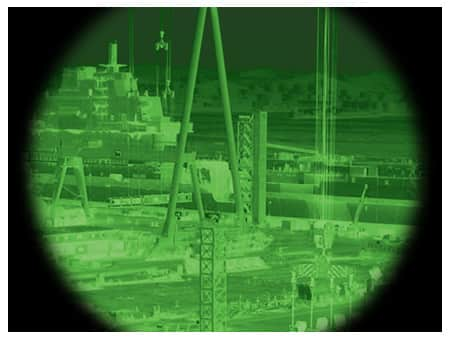A Primer on Night Vision Technology
Craig Pearson 07.24.12

Types of Night Vision Devices
There are many different ways and combinations of ways to see in the dark, and even more devices with which to do so. In the U.S., night vision devices are categorized into five “generations,” from Generation Zero to Generation Four, Generation Zero being the earliest night vision devices developed in the 1930s and used in WWII.
The Science Behind Night Vision
Night vision itself can be obtained in three main different ways, all used and combined in the different night vision device generations. The three ways are based on light enhancement, infrared light, and thermal radiation. The five Generations recognized by the U.S. military are all based around the idea of viewing infrared light and amplifying ambient light, rather than around thermal imaging.
Generation Technology
The first generation (Zero) of night vision goggles was based on viewing infrared light, but had no system of light amplification and required the presence of infrared light to see.
Generation One, however, as well as the following generations, is technology based on amplifying and effectively “gathering” ambient light and near-infrared light. Generation Zero and One night vision optics are the most affordable technology available for gun scopes, binoculars, and monoculars, among other devices. Generation One technology well help a user see much further than someone without a night vision device (up to 75-100 feet) but does not really compare with the technology of Generations Two, Three, and Four.
Generation Two introduces significant improvements in technology that allow night vision devices to be smaller, produce better images, and be more reliable than Generation One technology. Generation Two technology fails to provide much vision on extremely dark nights, however.
Generations Three and Four are very similar to each other, and it’s debatable which technology is “better.” The U.S. military uses Generation Three, which is much more sensitive and has a much higher resolution than Generation Two devices. Generation Four has improvements on Generation Three that (according to some) improve its resolution significantly. Some (including the military) claim, however, that the new technology has made Generation Four less reliable than Generation Three.
Thermal Imaging
The other main technology in night vision optics is thermal imaging, which isn’t considered as high quality or as natural as infrared-based night vision, but has its own benefits. Using thermal imaging you can see even on the blackest of nights without any use of infrared light, as thermal imaging can pick up the radiation generated from objects themselves.
If you are just beginning to learn about night vision devices, Generation Zero and One technology are an inexpensive technology to start with. There many applications range from home security to hunting, and the devices come in many different forms, from goggles to cameras and gun scopes. Whatever your needs and budget is, chances are there is a device suited just for you.
Craig Pearson is an avid hunter, outdoorsman, and adventurist. His main passions are hog hunting in Texas and writing about his many adventures. He currently blogs for nightvision 4 less, a supplier of high quality night vision equipment.

